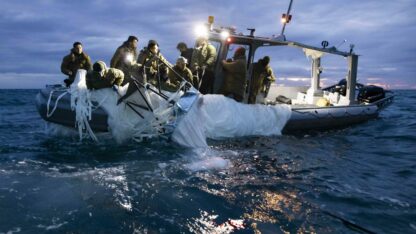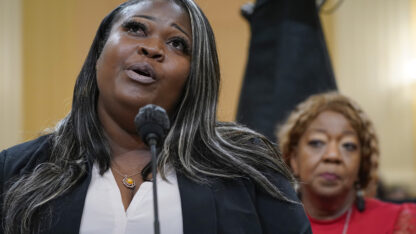A trade war, semiconductors, human rights: in recent years, the U.S.-China relationship has been rocked by successive geopolitical crises that have strained the dynamic between two of the world’s most powerful countries.
Now a balloon is threatening to derail any possibility of a diplomatic détente, with Beijing also accusing the U.S. of sending balloons to China.
Both the U.S. and China have traded fiery allegations of extensive aerial surveillance programs and injecting a new source of distrust and animosity between the two countries.
The balloon’s appearance earlier this month also prompted the U.S. to shoot down other “unidentified objects” in the sky, and sparked a fresh wave of criticism in Washington, with Republicans accusing President Joe Biden of not acting quickly enough or providing enough transparency.
Here’s a look at what’s happened so far.
Feb. 2: A senior U.S. defense official tells reporters that the U.S. is tracking a flying object and has “very high confidence” that the object is a Chinese high-altitude balloon and is flying over sensitive sites to collect information.
Domestic pressure immediately begins to build. Florida Republican Sen. Marco Rubio tweets the incident is “alarming but not surprising.”
Feb. 3: In a rare expression of contrition, China says it “regrets the unintended entry of the airship into U.S. airspace.” It insists the balloon was not there to spy on U.S. military sites, but was a civilian airship sent up for research purposes and had accidentally drifted over the U.S. due to weather currents.
Beijing’s apology comes less than 24 hours before Secretary of State Antony Blinken’s scheduled travel to Beijing to meet China’s top leader, Xi Jinping. Washington cancels the much-anticipated trip. China responds by saying no such trip had even been announced.
Feb. 4: A U.S. fighter plane shoots down the balloon as soon as it drifts over open water off the coast of South Carolina. China calls the downing of its balloon an “obvious overreaction” and continues to insist the balloon was a civilian research airship.
Feb. 6: China admits another high-altitude balloon, spotted over Latin America, belongs to it and says that airship was also conducting weather research.
Similar balloons were spotted as early as 2019, over Japan. Last winter, the U.S. Air Force in Hawaii scrambled jets to intercept an “unmanned balloon” off the island of Kauai. The head of Taiwan’s central weather bureau claims multiple balloons similar to the one shot down by the U.S. have appeared in Taiwan’s airspace, but later retracts his statement.
Feb. 8: The U.S. State Department tells reporters the shot-down Chinese balloon is part of a “fleet” of balloons overseen by the People’s Liberation Army. Pictures of the balloon, officials say, showed it had equipment onboard that a normal weather balloon would not need — including large solar panels, multiple antennas and sensors for intelligence surveillance.
Feb. 9: The U.S. briefs diplomats from 40 countries about the Chinese balloon it shot down. On Capitol Hill, both chambers of Congress receive classified briefings on the incident. The House passes a unanimous resolution condemning China’s alleged surveillance of the U.S.
Feb. 10: Friction between the U.S. and China over balloons continues to ramp up. The U.S. sanctions six civilian Chinese aerospace companies it says are supporting Beijing’s military surveillance efforts.
Feb. 10-12: The U.S. shoots down three unidentified objects in as many days, all found in North American airspace.
Asked by NPR’s Michel Martin about what he knows about these objects, Rep. Jim Himes of the House Intelligence Committee says: “It could be just residual experiments that were done by anyone, frankly. They might actually be active Wi-Fi balloons. They might actually be active weather balloons. I’m relatively sure that they’re not a threat in any way to the people of the United States or to our national security.”
Feb. 13: China hits back with its own balloon allegations, accusing the U.S. of flying its own high altitude balloons into Chinese airspace, without Beijing’s permission, on more than 10 occasions since January 2022.
Wang Wenbin, a Chinese foreign ministry spokesperson, says this shows the U.S. is “without a doubt the world’s largest surveillance habitual offender and surveillance empire.” The U.S. National Security Council denies the allegations.
“We do not send spy balloons over China, period,” Blinken tells NPR’s “Morning Edition,” in response to China’s accusation.
And the White House separately reassures Americans: “There is no – again, no — indication of aliens or extraterrestrial activity with these recent takedowns,” Press Secretary Karine Jean-Pierre says at her daily briefing.
Feb. 14: The U.S. military says it has recovered key sensors from the downed Chinese balloon. Senators receive a classified briefing on the unidentified objects, with members of both parties leaving the briefing saying they are assured that the spate of unidentified floating objects shot down by U.S. jets in recent days do not pose an immediate threat to Americans. But some urge Biden administration officials to share more information with the public after a classified briefing.
Emily Feng reported from Taipei. Lexie Schapitl reported from Washington, D.C. Vincent Ni and Padmananda Rama contributed to this report from Washington, D.C.
Copyright 2023 NPR. To see more, visit https://www.npr.org.
9(MDAxODM0MDY4MDEyMTY4NDA3MzI3YjkzMw004))

9(MDAxODM0MDY4MDEyMTY4NDA3MzI3YjkzMw004))









